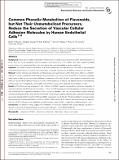Common phenolic metabolites of flavonoids, but not their unmetabolized precursors, reduce the secretion of vascular cellular adhesion molecules by human endothelial cells
Abstract
Background: Flavonoids have been implicated in the prevention of cardiovascular disease; however, their mechanisms of action have yet to be elucidated, possibly because most previous in vitro studies have used supraphysiological concentrations of unmetabolized flavonoids, overlooking their more bioavailable phenolic metabolites. Objective: We aimed to explore the effects of phenolic metabolites and their precursor flavonoids at physiologically achievable concentrations, in isolation and combination, on soluble vascular cellular adhesion molecule-1 (sVCAM-1). Method: Fourteen phenolic acid metabolites and 6 flavonoids were screened at 1 μM for their relative effects on sVCAM-1 secretion by human umbilical vein endothelial cells stimulated with tumor necrosis factor alpha (TNF-α). The active metabolites were further studied for their response at different concentrations (0.01 μM–100 μM), structure-activity relationships, and effect on vascular cellular adhesion molecule (VCAM)-1 mRNA expression. In addition, the additive activity of the metabolites and flavonoids was investigated by screening 25 unique mixtures at cumulative equimolar concentrations of 1 μM. Results: Of the 20 compounds screened at 1 μM, inhibition of sVCAM-1 secretion was elicited by 4 phenolic metabolites, of which protocatechuic acid (PCA) was the most active (−17.2%, P = 0.05). Investigations into their responses at different concentrations showed that PCA significantly reduced sVCAM-1 15.2–36.5% between 1 and 100 μM, protocatechuic acid-3-sulfate and isovanillic acid reduced sVCAM-1 levels 12.2–54.7% between 10 and 100 μM, and protocatechuic acid-4-sulfate and isovanillic acid-3-glucuronide reduced sVCAM-1 secretion 27.6% and 42.8%, respectively, only at 100 μM. PCA demonstrated the strongest protein response and was therefore explored for its effect on VCAM-1 mRNA, where 78.4% inhibition was observed only after treatment with 100 μM PCA. Mixtures of the metabolites showed no activity toward sVCAM-1, suggesting no additive activity at 1 μM. Conclusions: The present findings suggest that metabolism of flavonoids increases their vascular efficacy, resulting in a diversity of structures of varying bioactivity in human endothelial cells.
Citation
Warner , E F , Zhang , Q , Raheem , K S , O'Hagan , D , O’Connell , M A & Kay , C D 2016 , ' Common phenolic metabolites of flavonoids, but not their unmetabolized precursors, reduce the secretion of vascular cellular adhesion molecules by human endothelial cells ' , Journal of Nutrition , vol. 146 , no. 3 , pp. 465-473 . https://doi.org/10.3945/jn.115.217943
Publication
Journal of Nutrition
Status
Peer reviewed
ISSN
0022-3166Type
Journal article
Description
This study was supported by funding from the UK Biotechnology and Biological Sciences Research Council Diet and Health Research Industry Club (BBSRC-DRINC) (BB/I006028/1).Collections
Items in the St Andrews Research Repository are protected by copyright, with all rights reserved, unless otherwise indicated.

